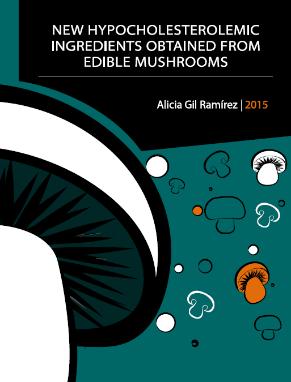New hypocholesterolemic ingredients obtained from edible mushrooms
Nuevos ingredientes alimentarios hipocolesterolemicos obtenidos a partir de hongos comestibles
(Defendida el 23 Julio de 2015)

Directores: Dra. Cristina Soler, Dr. Francisco R. Marín
The aim of this PhD. thesis was to evaluate the potential of edible mushrooms as novel sources of natural hypocholesterolemic compounds to develop specific food products with cholesterol lowering properties.
Cholesterol levels are strictly regulated to maintain its homeostasis therefore, if it is not absorbed with the diet, the cholesterol biosynthetic pathway is enhanced and vice versa. Nowadays, the commonly prescribed therapeutic treatments for hypocholesterolemic patients are targeted toward the reduction of both cholesterol intestinal absorption and/or its endogenous biosynthesis. But, when hypercholesterolemia is still moderate the consumption of food products with cholesterol-lowering capacities are more desirable than drugs. The marketed food supplemented with hypocholesterolemic compounds are only inhibiting mechanisms for cholesterol absorption. Consequently, in this work experiments were conducted to design a specific food supplemented with fungal extracts able of modulating cholesterol levels by both strategies as pharmaceutical drugs.
Previous reports suggested that some of the fungal hypocholesterolemic compounds exerted their activity via different mechanisms i.e. inhibiting the pancreatic lipase (PL) during digestion process or limiting the activity of the 3-hydroxy-3-methyl-glutaryl CoA reductase (HMGCR), the key enzyme in the cholesterol biosynthetic pathway (due to the presence of lovastatin) etc. However, when several mushroom extracts were tested using an in vitro digestion model that mimics the in vivo physiological conditions in gut, no interesting PL inhibition was noticed in strains that showed certain inhibitory capacity with in vitro enzymatic tests and therefore no further studies were performed.
On the other hand, lovastatin was not detected in extracts of mushrooms showing high HMGCR inhibitory activity thus, further identification of the responsible compounds was carried out. Specific water soluble polysaccharides with different structures depending on the mushroom specie were pointed as HMGCR inhibitors. They could be extracted from mushrooms with traditional and advanced technologies such as pressurized liquid extraction (PLE) or supercritical fluid extraction (SFE) and depending on the mushroom specie, their fragments could also retain their inhibitory activity at least until molecular weights of 1 KDa. When digested (in vitro) and applied to cell cultures resembling the enterocytic barrier (Caco2), they were detected at the basolateral compartment indicating that they were partly bioavailable and when the bioavailable fraction was applied to hepatic cell cultures (HepG2), they were able of modulating the expression of genes related to the cholesterol metabolism. However, the transcriptomic response was not directed toward a specific metabolic pathway suggesting that the changes observed in mRNAs profiles might be an indirect result of post-transcriptional events then, in vivo experiments were carried out using Lentinula edodes extracts.
Other compounds investigated for their potentiality as hypocholesterolemic molecules were the fungal dietary fibers (DF). DF-fractions obtained by classical and advanced methods such as pressurized water extraction (PWE) contained mainly ß-glucans and lower levels of chitins and ¿-glucans. They were acting as scavengers of bile acids during an in vitro digestion model with only a slightly lower effectivity than ß-glucans extracted from cereals. When applied to Caco2 cells they modulated a few cholesterol-related genes but differently depending on the mushroom specie studied. DF-fraction from Pleurotus ostreatus was selected and further tested to elucidate in vivo hypocholesterolemic influence.
Fungal sterols were also studied in detail because of their structural similarity with plant sterols (phytosterols/phytostanols). They could be extracted from mushroom fruiting bodies and from their by-products by PLE and SFE although sterol yields were higher in the latter. Obtained fractions contained mainly ergosterol although other derivatives were also found in quantities specie-dependent. Ergosterol and particularly SFE extracts obtained from Agaricus bisporus displaced cholesterol from dietary mixed micelles (DMM) more effectively than ß-sitosterol using an in vitro digestion model where DMMs were isolated. The mixture of ergosterol-enriched extracts with fungal ß-glucans reduced even more the presence of cholesterol in DMMs. When ergosterol containing DMMs were applied to Caco2 cell cultures they modified the transcriptional pattern of genes related to the cholesterol metabolism and also later on, the pattern of HepG2 cells. SFE-extracts were further used for animal trials.
In vivo studies using normo- and hypercholesterolemic mice models were carried out following different experimental settings depending on the mushroom extract investigated. None of the tested fungal extracts were able to lower significantly cholesterol levels in plasma and only some of them reduced triglycerides levels in liver. However, fungal sterols down-regulated genes involved in the cholesterol homeostasis (such as Srebf2 and Nr1h4 (FXR)) and the other mentioned extracts also stimulated transcriptional profiles similar to simvastatin or ezetimibe (two hypocholesterolemic drugs). Therefore, the three extracts were separately or pooled together into a high-lipid containing food matrix (simulating unhealthy dietary habits) and given in higher doses to mice during 4 weeks together with a high-cholesterol diet. All the extracts lowered cholesterol levels in serum particularly the ß-glucan extracts, but the modulated transcriptomic response was different than the one noticed by direct administration of the extracts. This and other observations suggested that the hypocholesterolemic effect of mushrooms extracts could be due to post-transcriptional changes being the observed modulations result of indirect effects. Moreover, the supplemented food including the mixture of the extracts showed similar hypocholesterolemic activities than the separate extracts indicating no positive synergies.
Universidad Autónoma de Madrid © 2008 · Ciudad Universitaria de Cantoblanco · 28049 Madrid · Información y Conserjería: 91 497 43 31 E-mail: informacion.ciencias@uam.es Gestión de estudiantes de Grado y Posgrado: 91 497 8264 / 4329 / 4353 / 4349 / 6879 / 8362 E-mail: administracion.ciencias@uam.es